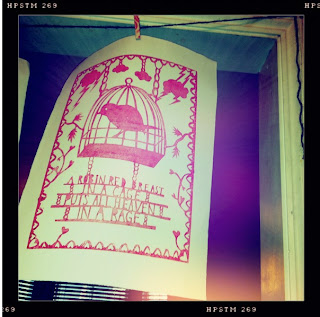One of the delights of the growing awareness of provenance and local-ness over the last few years has been the growth of regional potato crisps. They tend to be hand-cooked, farmer driven brands with a sense of charm and wit.
Salty Dog is an excellent name for a plethora of puns and fun. They have even bred a sister brand called
Darling Spuds. Their websites ooze authenticity and charm.
Kent Crisps come from the Quex Park estate, only recently launched and with a suitably Kentish twist to their flavours: Oyster and Vinegar, Ashmore Cheese and Onion, Sea Salt and Biddenden Cider Vinegar, and Sea Salt.
Yorkshire Crisps are 'moreish and convivial' and show a smattering of Yorkshire grit with their 'Nowt on' flavour (or lack of...)
Pipers, made by farmers in Lincolnshire, embrace the whole idea of regionality in all their flavours. I love the way they embrace the culture of supporting other independent producers with Anglesey Sea Salt, West Country Cheddar & Onion, using cheddar made by John Alvis at Lye Cross, Parsnip crisps using Biggleswade sweet chilli, Sea Salt and Somerset Cider Vinegar with cider vinegar made by Julian Temperley. The tone and generosity create a sense of well being that makes you feel warm about the brand, and the people behind it.
And then, linking to one of Pauline's recent posts, there are the
Lusty Pirate Cornish Pasty flavoured crisps. I don't know whether they have to make pasties, crimped on one side, with no carrot, and then extract the flavour - or whether the concept of 'flavour' covers a simpler method. They are definitely made in Cornwall. Another good concept for funning and punning, and what's not to love as Lusty himself says,"I like crisps and I love me pasties so I’ve combined the two and come up with some proper treasures."
The visual cues of these specialist products can be 'borrowed' by some larger manufacturers to try and send out the same authentic and trusted signals. I'm not saying their products are bad, but it is a slightly different offer.
Real crisps were an independent Welsh producer but are now part of the Tayto Group. They carefully side-step the question on their homepage "So who are we then?" The small print on the packaging needs to be carefully read so as not to be misled by the effectiveness of the graphic design.
Regionality is part of the trend that has seen the success of Farmers' Markets, Borough Market, Jamie Oliver - and a respect for cooking real food, allotments and seasonal food awareness. It's something that's well worth supporting and building on where we can.
 With a few moments on his hands Jonathan came across some lovely little movies on the Boden website. Having worked with them last year we're very pleased to see the spirit of the brand still echoing through the many layers of their communications. All their photography is stunning and their natural warmth and wit brings a smile to your face.
With a few moments on his hands Jonathan came across some lovely little movies on the Boden website. Having worked with them last year we're very pleased to see the spirit of the brand still echoing through the many layers of their communications. All their photography is stunning and their natural warmth and wit brings a smile to your face.
















































